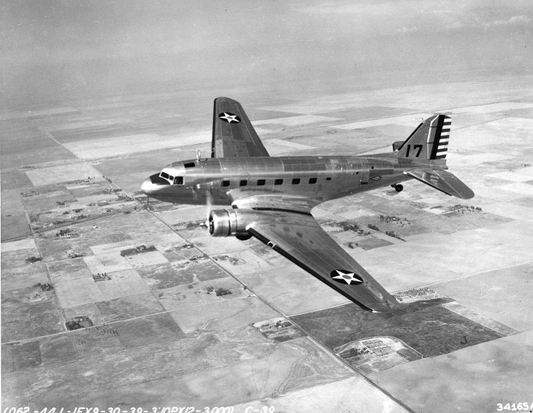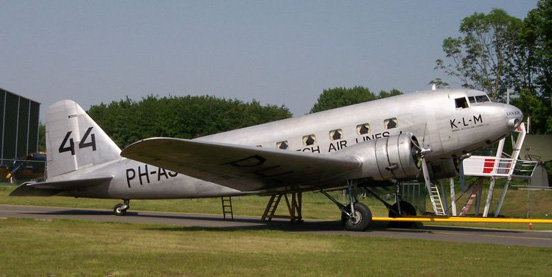 |
|
By
Wikipedia,
the free encyclopedia,
http://en.wikipedia.org/wiki/Douglas_DC-2
The Douglas DC-2 was a 14-seat, twin-propeller airliner produced by the Douglas Aircraft Corporation starting in 1934. It competed with the Boeing 247. In 1935 Douglas produced a larger version called the DC-3, which became one of the most successful airplanes in history.
Design and development
In the early 1930s, fears about the safety of wooden aircraft structures (responsible for the crash of a Fokker Trimotor) compelled the American aviation industry to develop all-metal types. With United Airlines having a monopoly on the Boeing 247, rival Transcontinental and Western Air issued a specification for an all-metal trimotor.
The response of the Douglas Aircraft Company was more radical. When it flew on July 1, 1933, the prototype DC-1 had a highly robust tapered wing, a retractable undercarriage, and only two 690 hp (515 kW) Wright radial engines driving variable-pitch propellers. It seated 12 passengers.
TWA accepted the basic design and ordered 20, with more powerful engines and seating for 14 passengers, as DC-2s. The design impressed a number of American and European airlines and further orders followed. Those for European customers KLM, LOT, Swissair, CLS and LAPE were assembled by Fokker in the Netherlands. 156 DC-2s were built.
Operational history
Although overshadowed by its ubiquitous successor, it was the DC-2 which first showed that passenger air travel could be comfortable, safe and reliable. As a token of this, KLM entered their first DC-2 PH-AJU Uiver (Stork) in the October 1934 MacRobertson Air Race between London and Melbourne. Out of the 20 entrants, it finished second behind only the purpose built de Havilland DH.88 racer Grosvenor House. During the total journey time of 90 h 13 min, it was in the air for 81 h 10 min, and won the handicap section of the race. (The DH.88 finished first in the handicap section, but the crew was by regulations allowed to claim only one victory.)
Variants
- DC-2A
- Two civil DC-2s, powered by two Pratt & Whitney R-1690 "Hornet" radial piston engines.
- DC-2B
- Two DC-2s sold to LOT Polish Airlines, fitted with two Bristol Pegasus VI radial piston engines.
Modified DC-2s built for the United States Army Air Corps under several military designations:
- XC-32
- 16-seat transport aircraft, later a flying command post, 1 built.
- C-32A
- Redesignated 24 commercial DC-2s impressed at the start of World War II.
- C-33
- Cargo transport aircraft, with a hinged cargo door in the aft fuselage, 18 built.
- YC-34
- VIP transport, later designated C-34, 2 built.
- C-38
- The first C-33 was modified with a DC-3 style tail section and two Wright R-1820-45 radial piston engines of 930 hp (694 kW) each. Originally designated C-33A but redesignated as prototype for C-39 variant. 1 built.
- C-39
- A composite of DC-2 & DC-3 components. Powered by two Wright R-1820-55 radial piston engines, of 975 hp (727 kW) each, 35 built.
- C-41/C-41A
- VIP transport powered by two Pratt & Whitney R-1830-21 radial piston engines, of 1,200 hp (895 kW) each, 1 of each built. The C-41 was the staff plane of Maj. Gen. Henry H. Arnold and the C-41A was used to fly the Secretary of War.
- C-42
- VIP transport, Powered by two Wright R-1820-53 radial piston engines, of 1200 hp (895 kW) each. 1 built in 1939 for the commanding general, GHQ Air Force, plus two similarly-converted C-39s procured in 1943.
- R2D
- One transport aircraft for the US Navy.
- R2D-1
- Four transport aircraft for the US Navy.
- Nakajima AT-2 / Ki-34
- Japanese license-built version
Operators
Civil operators
 Republic of China Republic of China
 Czechoslovakia Czechoslovakia
 Finland Finland
 Germany Germany
 Japan Japan
 Manchukuo Manchukuo
 Mexico Mexico
 Netherlands Netherlands
 Poland Poland
 Spanish Republic Spanish Republic
 Switzerland Switzerland
 United States United States
 Uruguay Uruguay
Military operators
 | |
Douglas C-39 transport, the military version of the DC-2 |
 Australia Australia
 Finland Finland
 Germany Germany
 Japan Japan
 Spanish Republic Spanish Republic
 United Kingdom United Kingdom
 United States United States
Survivors
 | |
DC-2 - c/n 1404 |
There are currently no DC-2s in commercial service. However, several aircraft made it into the 21st century:
- c/n 1404: The Aviodrome in Lelystad, the Netherlands, owns and operates one of the last flying DC-2. This former United States Navy aircraft is painted in the Uiver's KLM colour scheme and is sometimes seen on airshows in Europe. It is registered as NC39165 since 1945, though is now also wearing PH-AJU as a fictional registration to match that of the historic Uiver aircraft.
- c/n 1288: Also located at the Aviodrome in the Netherlands though owned by the Dutch Dakota Association. It is far from airworthy and will not be restored to such a condition. Its first operator was Eastern Air Lines.
- c/n 1368: A former Pan Am aircraft from 1932 that was used by the Douglas historical foundation until the merger with Boeing in 1997. It is now housed at the Museum of Flight in Seattle, Washington. This aircraft (N1934D) was restored to flying condition in 2007 and flown to Santa Maria, California for a new paint job. It received a TWA "The Lindbergh Line" livery and interior trim.
- One DC-2 is preserved at the Central Finland Aviation Museum. Another wingless fuselage (c/n 1562) is on display at the Finnish Aviation Museum.
- c/n 1292: There are three DC-2s surviving in Australia in 2006; this aircraft, c/n 1292, is one of ten ex-Eastern Airlines DC-2s purchased and operated by the RAAF during WW2 as A30-9. It is under restoration by [The Australian National Aviation Museum].
- c/n 1376 is owned by Steve Ferris in Sydney, Australia, and has been under restoration to flying status for many years. It was originally delivered to KNILM in 1935. At the outbreak of World War II it was flown to Australia and was conscripted into use with the Allied Directorate of Air Transport. In 1944 it joined Australian National Airways and finished its flying career in the 1950s with Marshall Airways. It is registered as VH-CDZ. It is the most complete of all the Australian DC2s as of 2008.
- c/n 1292 is under restoration at Moorabbin Airport in Victoria, Australia
- C-39A (s/n 38-515) is at the National Museum of the United States Air Force in Dayton, Ohio. The aircraft was donated to the Museum in July 1970. During its service life it was based at Wright-Patterson Air Force Base between 1939 and 1942. The aircraft is currently in storage at the Museum.
Specifications (DC-2)
General characteristics
- Crew: 2-3
- Capacity: 14 passengers
- Length: 62 ft 6 in (19.1 m)
- Wingspan: 85 ft 0 in (25.9 m)
- Height: 15 ft 10 in (4.8 m)
- Wing area: 940 ft² (87.3 m²)
- Empty weight: 12,455 lb (5,650 kg)
- Loaded weight: 18,560 lb (8,420 kg)
- Powerplant: 2× Wright Cyclone GR-F53 9-cylinder radial engines, 730 hp (540 kW) each
Performance
See also
Related development
Comparable aircraft
Related lists
External links
Text from Wikipedia is available under the Creative Commons Attribution/Share-Alike License; additional terms may apply.
Published in July 2009.
Click here to read more articles related to aviation and space!
|
 |



